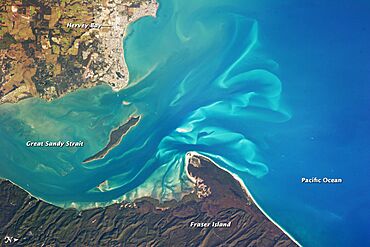Great Sandy Strait facts for kids
Quick facts for kids Great Sandy StraitQueensland |
|||||||||||||||
|---|---|---|---|---|---|---|---|---|---|---|---|---|---|---|---|

Great Sandy Strait from orbit
|
|||||||||||||||
| Population | 0 (2021 census) | ||||||||||||||
| • Density | 0/km2 (0/sq mi) | ||||||||||||||
| Postcode(s) | 4655 | ||||||||||||||
| Area | 613.2 km2 (236.8 sq mi) | ||||||||||||||
| Time zone | AEST (UTC+10:00) | ||||||||||||||
| LGA(s) | Fraser Coast Region | ||||||||||||||
| State electorate(s) |
|
||||||||||||||
| Federal Division(s) | |||||||||||||||
|
|||||||||||||||
The Great Sandy Strait is a long, narrow stretch of water in Queensland, Australia. It is about 70 kilometers (43 miles) long. This strait separates the mainland of Queensland from a large island called K'gari. The Great Sandy Strait is also considered a local area within the Fraser Coast Region. To the north of the strait, you'll find Hervey Bay. According to the 2021 census, very few people, if any, live directly in the Great Sandy Strait area.
Contents
Exploring the Geography of Great Sandy Strait
The Great Sandy Strait stretches from Hervey Bay in the north down to Inskip Point in the south. The Mary River flows into the strait near River Heads. This amazing waterway covers an area of about 932 square kilometers (360 square miles). At its southern end, the strait is about 2 kilometers (1.2 miles) wide.
Islands of the Great Sandy Strait
Many islands, both named and unnamed, are found within the strait. Some of the named islands, listed from north to south, include:
- Big Woody Island
- Round Island
- Little Woody Island
- Picnic Island
- Duck Island
- Walsh Island
- Turkey Island
- Bookar Island
- Thomas Island
- Slain Island
- Tooth Island
- Round Bush Island
- New Island
- Garden Island
- Dream Island
- Stewart Island
Most of these islands are low and sandy. Only a few, like Big Woody Island, rise higher, reaching about 50 meters (160 feet) above sea level. While most islands are not suitable for living, there is a small group of homes on the northwest side of Stewart Island.
A Look at the History of Great Sandy Strait
In 1799, a famous explorer named Matthew Flinders sailed along the coast from Moreton Bay to Hervey Bay. He was on his ship, the Norfolk. Flinders discovered that K'gari was actually an island, not connected to the mainland as people thought. However, he couldn't find a way to sail through the Great Sandy Strait. A monument called Matthew Flinders Lookout in Urangan remembers his explorations in the area.
The first European to successfully sail through the Great Sandy Strait was Lieutenant Joseph Dayman. He did this on November 10, 1846, in a small boat called the Asp. Dayman had planned to meet another ship, HMS Rattlesnake, but it had already left. He decided it was safer to go through the strait rather than risk the open ocean route around K'gari, especially because of a dangerous sandbar called Breaksea Spit.
Economy and Activities in the Strait
Tourism and commercial fishing are the two main industries in the Great Sandy Strait. Many people also enjoy boating and fishing here for fun.
The Environment of Great Sandy Strait
The Great Sandy Strait is a very important natural area. It has a mix of mangroves, sandbanks, mud islands, salt marshes, and seagrass beds. This makes it a perfect home for many animals. It's a crucial place for:
- Breeding fish
- Crustaceans (like crabs and prawns)
- Dugongs (also known as sea cows)
- Dolphins
- Marine turtles
Between July and November, migrating humpback whales use the calm waters of the strait to rest for a few days. The Great Sandy Strait is part of the Great Sandy Marine Park. It is also next to other protected areas like Great Sandy National Park, Poona National Park, and Great Sandy Conservation Park.
Birds of the Great Sandy Strait
|
Designations
|
|
| Official name: Great Sandy Strait | |
| Designated: | 14 June 1999 |
|---|---|
| Reference #: | 992 |
In 1999, the lower part of the Great Sandy Strait was recognized as a wetland of international importance under the Ramsar Convention. This means it's a very special place for birds and other wildlife. It's also a key resting spot for bird species listed under agreements with China (CAMBA) and Japan (JAMBA).
About 806 square kilometers (311 square miles) of the strait has been identified as an Important Bird Area by BirdLife International. This area supports around 120,000 non-breeding wading birds. It's home to over 1% of the world's population of several species, including:
- Bar-tailed godwits
- Eastern curlews
- Great knots
- Grey-tailed tattlers
- Lesser sand plovers
- Pied oystercatchers
- Red-necked stints
- Red-capped plovers
Small numbers of the mangrove honeyeater, a bird found only in certain areas, also live here.
Annual Events in the Strait
Every year in June, the Bay to Bay yacht race takes place on the Great Sandy Strait. This exciting sailing race is organized by the Hervey Bay Sailing Club.




